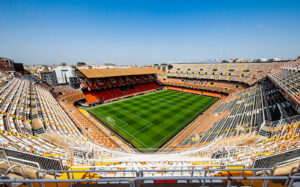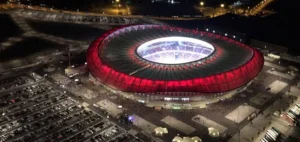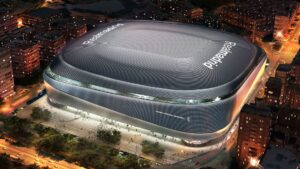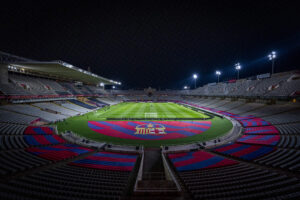Stadiums of the 2025/26 La Liga Season
The 2025/26 La Liga season, kicking off on August 15, 2025, promises a thrilling display of Spanish football, with 20 iconic stadiums serving as the stage for the drama. With Levante, Elche, and Real Oviedo promoted to replace relegated Valladolid, Las Palmas, and Leganés, the league welcomes a mix of historic venues and vibrant arenas. This blog presents a complete list of La Liga’s stadiums, highlights the oldest, newest, and most iconic grounds, delves into the promoted teams’ venues with defining historical moments, and adds fascinating details to showcase their unique character.
All 20 La Liga Stadiums for 2025/26
Below is a table of the teams and their home stadiums for the 2025/26 La Liga season, including approximate capacities and locations, based on the latest available data.
|
Team
|
Stadium
|
Capacity
|
Location
|
|---|---|---|---|
|
Athletic Bilbao
|
San Mamés
|
53,331
|
Bilbao
|
|
Atlético Madrid
|
Civitas Metropolitano
|
70,460
|
Madrid
|
|
Barcelona
|
Estadi Olímpic Lluís Companys
|
55,926
|
Barcelona
|
|
Celta Vigo
|
Balaídos
|
29,000
|
Vigo
|
|
Deportivo Alavés
|
Mendizorroza
|
19,840
|
Vitoria-Gasteiz
|
|
Elche
|
Manuel Martínez Valero
|
33,732
|
Elche
|
|
Espanyol
|
RCDE Stadium (Stage Front Stadium)
|
40,000
|
Cornellà de Llobregat
|
|
Getafe
|
Coliseum Alfonso Pérez
|
16,500
|
Getafe
|
|
Girona
|
Montilivi
|
13,400
|
Girona
|
|
Levante
|
Ciutat de València
|
26,354
|
Valencia
|
|
Mallorca
|
Mallorca Son Moix
|
23,142
|
Palma
|
|
Osasuna
|
El Sadar
|
23,576
|
Pamplona
|
|
Rayo Vallecano
|
Campo de Vallecas
|
14,708
|
Madrid
|
|
Real Betis
|
Benito Villamarín
|
60,721
|
Seville
|
|
Real Madrid
|
Santiago Bernabéu
|
81,044
|
Madrid
|
|
Real Oviedo
|
Carlos Tartiere
|
30,500
|
Oviedo
|
|
Real Sociedad
|
Reale Arena (Anoeta)
|
39,500
|
San Sebastián
|
|
Sevilla
|
Ramón Sánchez Pizjuán
|
43,883
|
Seville
|
|
Valencia
|
Mestalla
|
55,000
|
Valencia
|
|
Villarreal
|
Estadio de la Cerámica
|
23,008
|
Villarreal
|
With an average capacity of around 35,000, these stadiums reflect La Liga’s passionate fanbase, with Madrid, Catalonia, and Andalusia hosting clusters of clubs.
The Oldest Stadium: Mestalla (Valencia)
 Established: 1923
Established: 1923- Details: Mestalla, home to Valencia CF, is La Liga’s oldest stadium for the 2025/26 season, with a 55,000 capacity. Its steep stands, particularly the “Grada Nord” where ultras gather, create an intense, intimidating atmosphere that’s a hallmark of Spanish football. This historic venue retains its early 20th-century charm while hosting modern La Liga battles.
- Historical Moment: On May 9, 2001, Mestalla saw Valencia’s 3-0 Champions League semi-final victory over Leeds United, with 53,000 fans propelling the team to their second consecutive final, a defining moment in the stadium’s storied legacy.
- Fascinating Fact: The stadium’s iconic bat symbol, tied to Valencia’s crest, adorns the stands, and its aging concrete terraces evoke the gritty passion of Spanish football’s golden era.
The Newest Stadium: Civitas Metropolitano (Atlético Madrid)
 Established: 2017
Established: 2017- Details: The Civitas Metropolitano, Atlético Madrid’s 70,460-capacity home, is La Liga’s newest stadium, opened in 2017. Replacing the Vicente Calderón, this sleek, eco-friendly arena with LED lighting and modern amenities offers a vibrant matchday experience, enhanced by the passionate “Neptuno” fan zone.
- Historical Moment: On September 16, 2017, the stadium’s inaugural match saw Atlético Madrid defeat Málaga 1-0 before 63,000 fans, marking the start of a new era for Los Colchoneros.
- Fascinating Fact: The “Neptuno” fan zone, named after Atlético’s iconic fountain, hosts pre-match celebrations, blending the club’s traditions with the stadium’s cutting-edge design.
The Most Iconic Stadium: Santiago Bernabéu (Real Madrid)
 Established: 1947
Established: 1947- Details: The Santiago Bernabéu, Real Madrid’s 81,044-capacity home, is La Liga’s most iconic stadium, renowned as the “Stadium of the Future” with its 360-degree screen and retractable roof. A global football landmark, it hosts the world’s most successful club and draws fans for its unmatched prestige.
- Historical Moment: On June 25, 1980, the Bernabéu hosted the European Cup final, where Nottingham Forest defeated Hamburg 1-0 before 51,000 fans, a historic moment that showcased its status as a stage for European glory.
- Fascinating Fact: The stadium’s trophy room, displaying Real Madrid’s 15 Champions League titles, is a must-visit, making the Bernabéu a pilgrimage site for football enthusiasts worldwide.
Spotlight on Promoted Teams’ Stadiums
Levante, Elche, and Real Oviedo bring a mix of grit and ambition to La Liga. Here’s a look at their stadiums, each with a defining moment and unique charm.Levante’s Ciutat de València, opened in 1969 with a 26,354 capacity, is a compact fortress known for its passionate atmosphere. The “Granota” fans in the main stand create a wall of noise, and recent upgrades keep it functional yet soulful. On May 13, 2011, a 1-1 draw with Barcelona secured Levante’s first-ever Europa League qualification, with 20,000 fans erupting in celebration. The stadium’s quirky frog mascot, tied to Levante’s “Granotas” nickname, is painted on concourses, reflecting local pride. Elche’s Manuel Martínez Valero, established in 1976, holds 33,732 fans and is known for its spacious, open design. The “Franjiverdes” supporters bring intensity, especially during derbies. On June 20, 1985, it hosted the Copa del Rey final, where Athletic Bilbao beat Atlético Madrid 2-1 before a packed crowd, a rare honor for a mid-sized club. The stadium’s palm tree-lined surroundings nod to Elche’s agricultural heritage, adding a unique Mediterranean vibe. Real Oviedo’s Carlos Tartiere, opened in 2000 with a 30,500 capacity, replaced an older namesake and reflects Oviedo’s loyal fanbase. The “Carbayones” generate a fierce atmosphere in the north stand. On June 3, 2000, its inaugural match saw Oviedo draw 0-0 with Las Palmas, marking their return to modern facilities after a 24-year top-flight absence. The stadium’s blue exterior mirrors Oviedo’s colors, and its hilltop location offers stunning city views.
Additional Stadium Highlights
San Mamés (Athletic Bilbao), rebuilt in 2013, blends tradition with modernity, hosting AC/DC’s final concert with Malcolm Young in 2016. Its 53,331 capacity and steep stands amplify the Basque passion. Estadi Olímpic Lluís Companys (Barcelona), a temporary 55,926-seat home during Camp Nou’s 2023-2026 renovation, hosted the 1992 Olympics football final. Ramón Sánchez Pizjuán (Sevilla), with 43,883 seats since 1958, is famed for its intense atmosphere during derbies, with a mosaic of Sevilla’s crest visible from above. Montilivi (Girona), the smallest at 13,400, creates an intimate, raucous vibe, with its single-tier stand evoking a community spirit.

From Mestalla’s 102-year legacy to the cutting-edge Civitas Metropolitano, the 2025/26 La Liga season’s stadiums weave a rich tapestry of history and innovation. The Santiago Bernabéu’s iconic grandeur, Ciutat de València’s gritty charm, and Carlos Tartiere’s modern pride promise unforgettable moments. Which stadium’s story resonates with you? Get your tickets from here and dive into the vibrant atmosphere, becoming part of La Liga’s thrilling matches!

